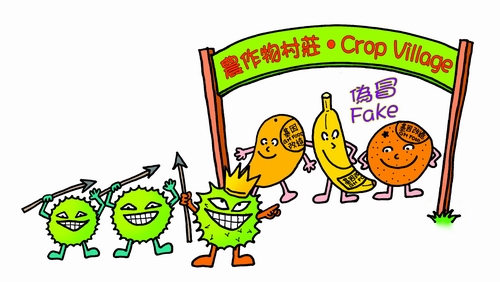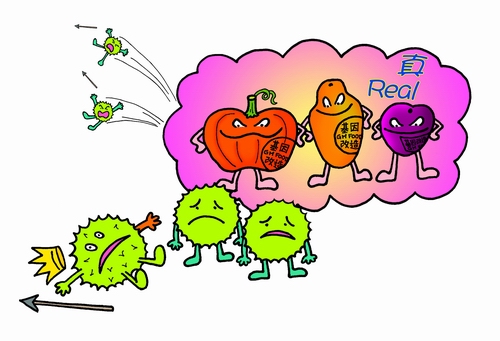Crack the Code of GM Food
In a Crop Village, there are villagers of different crop families such as Mango, Banana, and Papaya, etc. One day, Virus King plans to attack the village and two virus soldiers are reporting to the king.
Virus Soldier A: My Lord, according to our scout, the villagers in the Crop Village have put a "Genetically Modified" (GM) label in front of their family's name. In that case, we can't attack those families, as I heard that those with the GM label means that they have been modified and become toxic. I think we should retreat now!
Virus Soldier B: No, no, no, my Lord, I know that GM crops are modified to have different properties. Some GM crops are actually modified to contain a gene for a toxin from the bacterium Bacillus thuringiensis (Bt). This toxin is an insecticide for killing insect but not virus. On the other hand, some GM crops are modified so that they can tolerate herbicide for killing weeds, and the crops can live better. We are virus! We don't need to be afraid!
Virus Soldier A: My Lord, he only knows part of the facts. Other than the mentioned properties, I know that genetically modification can add a gene taken from us to the crops which subsequently can develop resistance to us!
Virus King: Am………Both of you just know part of the facts. Actually, GM food doesn't mean that they have all the properties in one type of crops, although some crops may have one or more modifications. For example, there is GM potato that resists to insect and virus. Hence, even if it is GM crops, it doesn't mean that it must be resistant to us. Which families of the Crop Village have that label?
Virus Soldier B: All of them! They are Mango, Banana, Papaya, Plum , Squash, Orange.
Virus King: All of them?! That's impossible. Do you know that only some crops have their GM counterparts? There is no GM Mango, Banana, and Orange in the market, though their GM counterparts with growth advantage may be developed in the future. On the other hand, GM Papaya, GM Plum , and GM Squash are resistant to different types of virus. For example, GM papaya 55-1/63-1 can resist papaya ringspot virus (PRSV) and GM plum C5 can resist plum pox virus.
Virus Soldier A&B: Am... er... er...
Virus King: Do you know what we should do now?
Virus Soldier A&B: We should only go to attack GM Mango, GM Banana, and GM Orange because they must be fake and not GM!
Virus King: Good! Go! Go! Go!
After a while, Virus Soldier A & B sadly come back to the Virus King.
Virus Soldier A: My Lord, we fail in attacking the Crop Village ……….
Virus King: What?!
Virus Soldier B: We are faked by the villagers. The villagers in Crop Village switched their houses. When we attacked the houses of GM Mango, GM Banana, and GM Orange, we actually attacked GM Papaya, GM Plum , and GM Squash and they are resistant to us.
Virus King passes out in front of his soldiers.


According to the "Guidelines on Voluntary Labelling of Genetically Modified Food" published by the Centre for Food Safety, negative labelling is not recommended for food without GM counterparts, as it would be misleading to consumers. For example, mango should not be labelled as "Non-GM Mango". In addition, GM crops that are underdevelopment are not considered as GM counterparts. Below is a summary table containing some examples of crops with GM counterparts:-
| Trait | ||||
|---|---|---|---|---|
| Herbicide tolerant | Insect resistant | Virus resistant | Others | |
| GM crops |
|
|
|
|